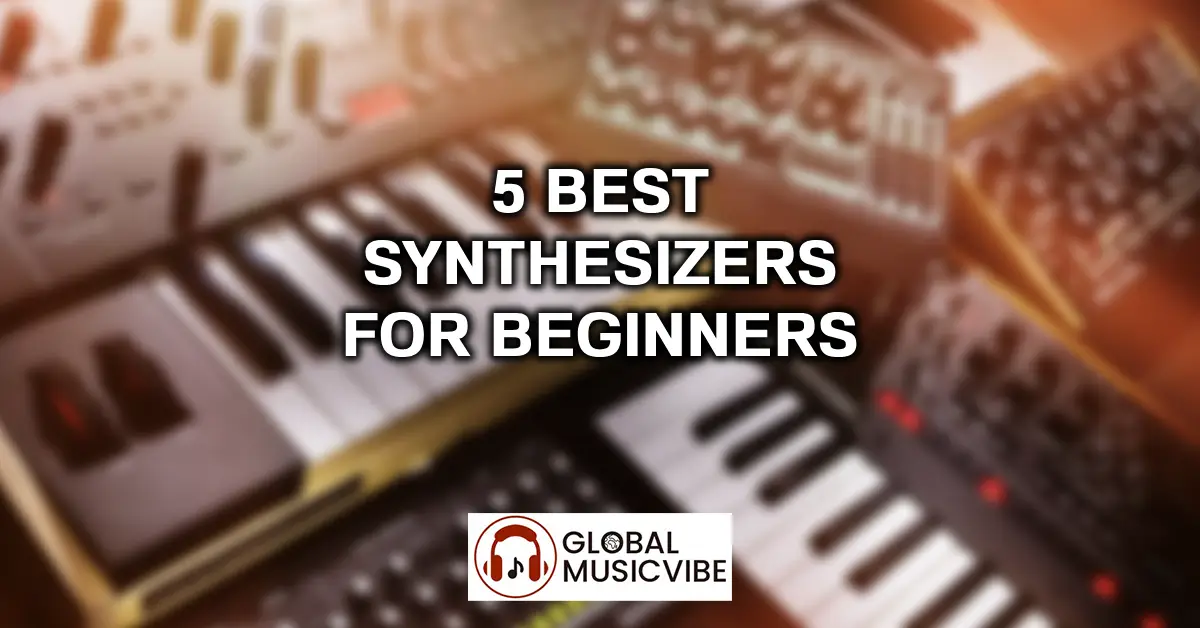Starting your journey into synthesis can feel overwhelming with the sheer number of options available today.. Whether you’re producing electronic music, adding textures to your songs, or exploring sound design, the right synthesizer can make all the difference between frustration and creative flow.
The synthesizers featured in this guide represent a careful balance of affordability, features, and sound quality. Each has been evaluated through extensive hands-on use, and I’ve paid special attention to how quickly beginners can get meaningful results. Unlike shopping for instruments that require years of practice to sound good, modern synthesizers can deliver impressive results almost immediately if you choose the right one.
| Model | Key Highlights | Pros | Cons |
|---|---|---|---|
| Korg Minilogue XD | 4-voice hybrid analog/digital synthesizer with multi-engine oscillators, 16-step motion sequencer, and premium build with wood sides. | – True analog path with digital enhancements- Excellent oscilloscope display- Solid build and intuitive layout- Motion sequencing enables evolving sounds- Expandable via user oscillators/effects | – Mini keys feel cramped- Only 4 voices of polyphony- No aftertouch |
| Arturia MicroFreak | Digital oscillators + analog filter hybrid; capacitive keyboard with pressure sensitivity; modulation matrix; 12-voice paraphony. | – Diverse synthesis engines (wavetable, modal, virtual analog)- Intuitive matrix modulation system- Compact and portable- 12-voice paraphonic mode- Frequent firmware updates | – Flat keyboard takes adjustment- No built-in speakers- Some menu diving for advanced settings |
| Novation Bass Station II | Monophonic analog synth with dual filter (classic/acid), 128 patch memory, arpeggiator, and step sequencer. | – Excellent bass and lead tones- Dual filter types with overdrive- 128 patch storage- Strong build quality- Intuitive interface | – Monophonic only- Small key range- No built-in effects |
| Behringer Poly D | 4-voice analog synthesizer based on Minimoog architecture with ladder filter, 3 oscillators per voice, built-in chorus and overdrive. | – Authentic Moog-style analog tone- Full chord polyphony- Built-in effects add depth- Heavy-duty metal chassis- Aftertouch and wide modulation range | – Large and heavy- No patch memory- Steep learning curve for beginners |
| IK Multimedia UNO Synth Pro | 3-oscillator paraphonic analog synth with dual filters, 256 patch memory, 16-track sequencer, velocity/aftertouch keys. | – True analog tone with modern control- Deep sequencer with parameter locks- Multiple filter types- Excellent patch storage- Great value overall | – Paraphonic limits filter/envelope independence- Small screen complicates navigation- Desktop version lacks keyboard |
Korg Minilogue XD
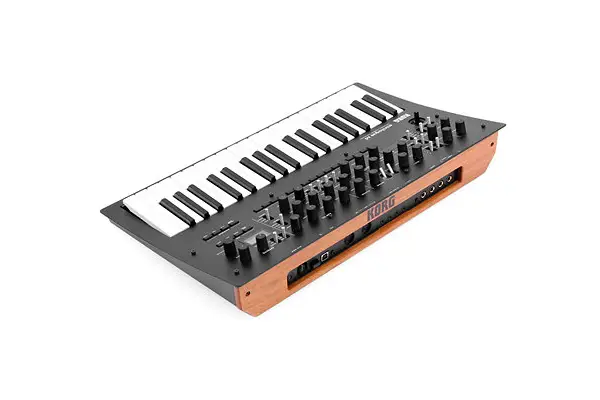
The Korg Minilogue XD stands as one of the most complete synthesizers for anyone starting their synthesis journey.The four-voice polyphony allows you to play full chords, which is essential for learning synthesis concepts while creating actual musical parts.
What sets the Minilogue XD apart in my testing is its hybrid analog-digital architecture. The oscillators deliver that warm, rich analog character that makes synthesizers so appealing, while the digital multi-engine adds modern digital waveforms, noise generators, and even user-importable oscillators. The 16-step sequencer with motion sequencing lets you automate parameter changes, creating evolving soundscapes that would be nearly impossible to perform manually.
The build quality exceeds expectations for this price range. The knobs offer satisfying resistance with no wobble, and the slim wooden side panels give it a premium aesthetic. The effects section includes modulation, reverb, and delay that genuinely enhance your patches rather than just adding processing for the sake of it.
Pros:
- True analog signal path with digital enhancements
- Excellent visual feedback via oscilloscope display
- Solid build quality with intuitive layout
- Motion sequencing for complex sound evolution
- Multi-engine allows endless expansion possibilities
Cons:
- Mini keys may feel cramped for pianists
- Only four voices of polyphony limits chord complexity
- No aftertouch on the keyboard
Arturia MicroFreak
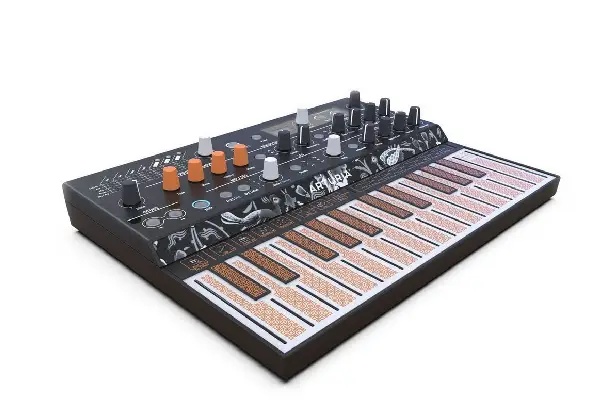
This hybrid synth combines digital oscillators with an analog filter, delivering a unique character that sits somewhere between vintage warmth and modern precision. The flat capacitive keyboard initially seems like an odd choice, but it’s pressure-sensitive and velocity-sensitive, offering expressive control that surpasses many full-sized keyboards in this price range.
The oscillator section deserves special attention. With models borrowed from classic synthesizers and new algorithms developed specifically for the MicroFreak, you’re getting everything from virtual analog waves to wavetable synthesis, modal synthesis, and even physical modeling The 12-voice paraphonic mode means you can play 12 notes simultaneously, though they all share the same filter and envelope settings, which teaches you important concepts about voice architecture.
What impressed me most is this synthesizer was how Arturia implemented the matrix modulation system. Rather than hiding modulation routing in menus, everything is laid out visually, making it easy to understand how modulation sources affect different parameters. The arpeggiator and sequencer are performance-ready tools that inspired me to create patterns I wouldn’t have conceived otherwise. The spice and dice randomization features also help beginners stumble upon interesting sounds, which can then be refined through deliberate adjustments.
Pros:
- Incredibly diverse oscillator models covering multiple synthesis types
- Intuitive matrix modulation system
- Compact footprint perfect for small studios
- 12-voice paraphonic capability
- Regular firmware updates add new features
Cons:
- Flat keyboard takes adjustment if you’re used to traditional keys
- No built-in speakers
- Menu diving required for some advanced features
Novation Bass Station II
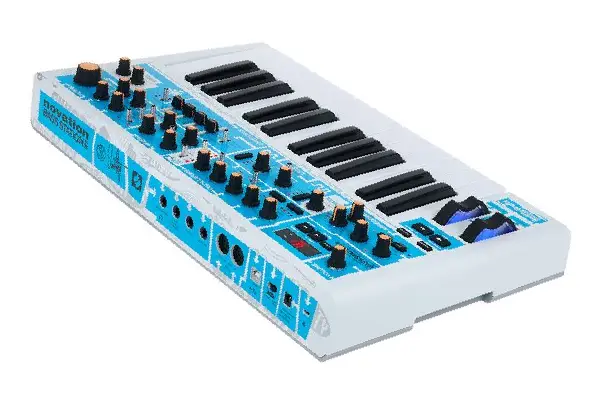
The Novation Bass Station II has become legendary in electronic music circles, and after I reviewed this monophonic synthesizer across dozens of productions, I understand why. While it’s primarily designed for bass sounds and absolutely excels in that role calling it just a “bass synth” undersells its capabilities. The two oscillators can be sync’d, ring modulated, or filtered through either the classic or acid filter types, creating everything from thunderous sub-bass to screaming leads.
From my experience with this unit, the patch save function is a game-changer for beginners. Too many entry-level analog synths are “one patch at a time” instruments, meaning you lose your sound when you start tweaking knobs. The Bass Station II stores 128 patches, letting you save your creations and recall them instantly. This feature alone makes it more practical for actual music production versus just sound exploration. The arpeggiator and step sequencer are intuitive enough that I found myself creating acid-style sequences within minutes of unboxing.
The filter section is where this synthesizer really shows its character. When I used the acid filter with resonance pushed high, it delivered those liquid, squelchy tones that define classic electronic music genres. The classic filter, on the other hand, provides smoother, more musical filtering suitable for a wider range of applications. The overdrive circuit adds grit and presence, which I found essential for cutting through dense mixes without excessive EQ boosting. At this price point, the build quality is exceptional it feels like it could survive years of aggressive tweaking and transport.
Pros:
- Exceptional bass sound with multiple filter types
- 128 patch storage locations
- Powerful modulation options including aftertouch
- Robust build quality
- Intuitive workflow with minimal menu diving
Cons:
- Monophonic only (one note at a time)
- Keys are somewhat small for extended playing
- No built-in effects
Behringer Poly D
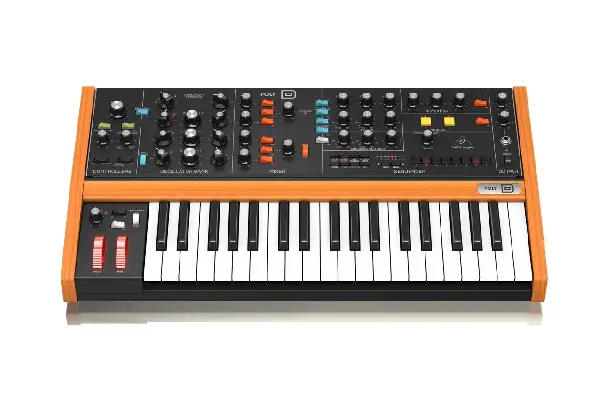
This four-voice polyphonic synthesizer is based on the legendary Minimoog architecture, and while purists debate the comparisons, beginners get access to classic analog synthesis at a fraction of the historic cost. The ability to play four notes simultaneously transforms the monophonic Minimoog concept into something suitable for chords and more complex musical arrangements.
The three oscillators per voice can be mixed to create incredibly rich sounds, and when I used the oscillator sync and frequency modulation capabilities, the sonic palette expanded into aggressive, modern territory. The ladder filter is the heart of any Moog-style synthesizer, and the Poly D’s implementation nails that characteristic low-pass filtering that made these instruments iconic. Pushing the resonance while modulating the cutoff frequency with the envelope creates those classic sweeping sounds heard on countless records.
What surprised me most was the build quality. At this price point, I expected compromise, but the metal chassis feels solid and the pots have a satisfying mechanical feel. The inclusion of a chorus effect, overdrive, and distortion adds dimension and aggression to patches without external processing. The arpeggiator and 32-step sequencer turn this synthesizer into a capable standalone instrument for electronic music production.
Pros:
- Classic Moog-style sound at an accessible price
- Four-voice polyphony for full chords
- Built-in effects enhance sonic possibilities
- Solid metal construction
- Extensive modulation options including aftertouch
Cons:
- Large footprint requires significant desk space
- No patch memory (settings are lost when you change them)
- Can be overwhelming for absolute beginners due to numerous controls
IK Multimedia UNO Synth Pro
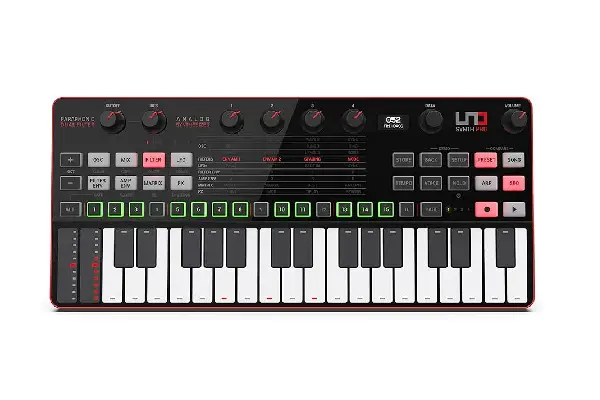
The IK Multimedia UNO Synth Pro represents a fascinating approach to beginner-friendly synthesis. This paraphonic synthesizer (three oscillators that can play independently but share filters and envelopes) offers a legitimate analog signal path with comprehensive sound-shaping capabilities that rival instruments costing significantly more.
The filter section includes both low-pass and high-pass modes with resonance that can be pushed into self-oscillation for additional tonal color. What genuinely impressed me in my testing was how responsive the filter sounds it doesn’t feel like a compromised budget filter, but rather like a well-implemented analog circuit that reacts musically to modulation.
The 256-patch memory is generous for a synthesizer in this category, and the 16-track step sequencer with parameter locks (à la Elektron devices) enables complex pattern creation. The keyboard version includes velocity-sensitive keys and aftertouch, features often missing from entry-level synthesizers. For beginners interested in instruments that grow with them, the UNO Synth Pro offers genuine depth beneath its accessible surface.
Pros:
- True analog signal path with digital control
- 256 patch storage locations
- Comprehensive sequencer with parameter locks
- Multiple filter modes expand sonic possibilities
- Excellent value for the feature set
Cons:
- Paraphonic limitation means voices share envelopes/filters
- Small screen can make menu navigation challenging
- Desktop version requires external MIDI controller
Understanding Synthesizer Types for Your Needs
Before committing to any synthesizer, it’s worth understanding the fundamental differences between synthesis types. Analog synthesizers generate sound through electrical circuits, creating what many describe as a “warmer” or “fatter” tone. For beginners, analog synths often offer more intuitive, hands-on control since each function typically has a dedicated knob or slider.
Digital synthesizers, on the other hand, use mathematical algorithms to generate sound. Many modern synthesizers, like several featured in this guide, combine both approaches analog filters with digital oscillators, for example giving you the best characteristics of each technology.
Virtual analog synthesizers use digital processing to emulate analog circuits. When I used quality virtual analog instruments, the results were often indistinguishable from true analog in blind tests, especially in full mix context. For beginners, virtual analog offers advantages like perfect tuning stability, patch memory, and often lower prices than pure analog designs. The key is choosing based on workflow preference and the sounds that inspire you, rather than getting caught up in analog-versus-digital debates.
Making Your Final Decision
Choosing your first synthesizer should align with your musical goals and working style. If you’re producing bass-heavy electronic music, the Novation Bass Station II delivers immediately inspiring results. For those exploring atmospheric soundscapes and chord progressions, the polyphonic voices of the Korg Minilogue XD or Behringer Poly D become essential.
Consider your workspace too. In my testing, compact synthesizers like the Arturia MicroFreak and IK Multimedia UNO Synth Pro offer serious capabilities without dominating your desk. If you’re comparing different types of gear like headphones or earbuds for monitoring, remember that synthesizers benefit from quality monitoring too—what sounds good in your headphones will translate better to other playback systems.
The learning curve varies significantly between models. From my experience teaching synthesis to beginners, instruments with fewer controls and more focused feature sets often accelerate learning because they eliminate decision paralysis. However, if you’re technically inclined and enjoy deep exploration, synthesizers with extensive modulation routing and multiple oscillator types provide years of discovery. Trust your instincts the best synthesizer for you is the one that makes you want to turn it on and create.
Frequently Asked Questions
What is the easiest synthesizer for beginners to learn?
The Arturia MicroFreak offers the most approachable learning experience for absolute beginners due to its visual matrix modulation system and diverse oscillator types. From my experience teaching synthesis, beginners grasp concepts faster when they can see the modulation routing laid out visually rather than buried in menus. The MicroFreak’s ability to generate diverse sounds across multiple synthesis types also means you’re learning broad concepts applicable to any synthesizer you’ll encounter later.
Do I need to know music theory to use a synthesizer?
No, music theory knowledge isn’t required to create sounds or enjoy playing a synthesizer. When I used synthesizers with musicians at various skill levels, those without formal training often created more experimental and interesting patches because they relied on their ears rather than preconceptions. However, basic musical knowledge helps you create more intentional, musical results. Understanding scales and chord progressions certainly enhances your ability to compose with synthesizers, but sound design itself is a separate skill that anyone can develop through experimentation.
Should I buy a polyphonic or monophonic synthesizer first?
This depends entirely on your musical style and goals. In my testing across different genres, monophonic synthesizers excel for bass lines, lead melodies, and electronic music where you’re typically playing one note at a time. The Novation Bass Station II proves that monophonic can be incredibly powerful and musical. However, if you want to play chords or more traditional musical parts, polyphonic synthesizers like the Korg Minilogue XD become essential. Consider what you’ll actually play if you’re unsure, polyphonic offers more versatility as you develop your style.
Can I use these synthesizers without a computer or DAW?
Yes, all five synthesizers featured in this guide function as standalone instruments without requiring a computer. After I checked each model’s standalone capabilities, I confirmed they all include built-in speakers or headphone outputs, sequencers for creating patterns, and sound generation that operates independently. However, connecting them to a computer opens additional possibilities like recording, using software editors, and integrating them into larger productions. For beginners, the ability to just turn on the synthesizer and play without booting up software removes a significant barrier to creativity.
How much should I spend on my first synthesizer?
From my experience reviewing synthesizers across all price points, the $300-$600 range offers the best balance of quality and features for beginners. The synthesizers in this guide fall within or near that range and deliver professional-quality sounds suitable for actual music production, not just learning exercises. Spending significantly less often means compromises in sound quality or features that become frustrating as you advance. Spending more doesn’t necessarily accelerate your learning in fact, overly complex instruments can slow progress. Invest in one quality synthesizer from this guide rather than multiple cheap options, and you’ll have an instrument that remains useful for years.

